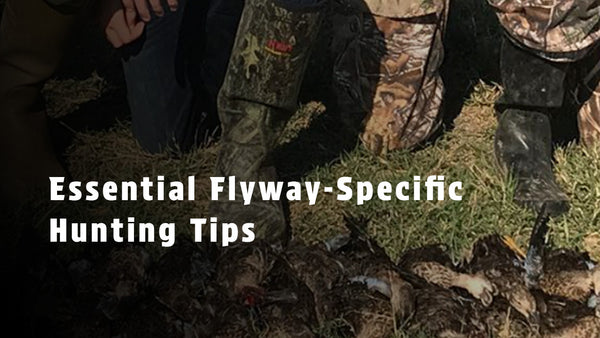
Duck Hunting Seasons and Flyways
Duck hunting success depends on two major factors: timing and location. Understanding duck hunting seasons and the flyways ducks follow during their migrations will dramatically improve your chances of a rewarding hunt. To make the most of your duck hunting trips, it's crucial to learn about flyways, their characteristics, and how seasonal changes impact hunting conditions.
We’ve studied duck migration patterns and regulations in detail and compiled our top insights below:
Flyways Across the United States
The United States is divided into four primary migratory flyways, each offering unique hunting opportunities. Knowing which flyway you’re hunting in will help you select the right gear, decoys, and tactics.
Atlantic Flyway
This route stretches from the Canadian Maritimes down the East Coast to Florida. It’s known for sea ducks, black ducks, and puddle ducks like mallards and teal. Hunting in this flyway often involves salt marshes, tidal creeks, and open bays.
Mississippi Flyway
One of the most heavily trafficked flyways, it runs from central Canada down the Mississippi River to the Gulf of America. It hosts mallards, pintails, canvasbacks, and gadwalls. Hunters here often use river blinds, flooded timber, and backwater sloughs.
Central Flyway
Covering the Great Plains from Canada to the Texas Gulf Coast, this flyway is famous for divers and puddle ducks. Prairie potholes, stock ponds, and shallow lakes are common hunting spots.
Pacific Flyway
Running along the Pacific Coast from Alaska to Mexico, this flyway offers opportunities for species like wigeon, pintails, and scaup. Hunters frequent coastal estuaries, inland marshes, and agricultural fields.
Duck Hunting Seasons
Each flyway has designated hunting seasons regulated by federal and state agencies. These seasons typically fall between early September and late January and are divided into early, regular, and sometimes late segments.
Early Season
Mainly for teal and local ducks. Warm weather means lighter gear requirements, but ducks are wary and easily spooked.
Regular Season
This is the core hunting period when the bulk of migratory birds pass through. Cold fronts and weather shifts bring new flocks daily, making this the most productive time.

Late Season
Often overlaps with diver and sea duck migrations. Expect icy conditions, frozen waters, and the need for extra cold-weather gear.
Choosing the Right Location by Flyway and Season
Atlantic Flyway in Early Fall
Focus on coastal marshes for early teal. Light camo and small spreads of decoys work best.
Mississippi Flyway in Mid-Season
Flooded timber is king. Large spreads of mallard decoys, jerk cords, and reliable waders are must-haves.
Central Flyway in Late Fall
Hit the prairie potholes and shallow lakes for mixed bags of divers and puddlers. Ice-breaking equipment may be necessary.
Pacific Flyway in Late Season
Target rice fields and estuaries for pintails and wigeon. Waterproof, insulated gear is essential to combat cold, wet conditions.
Essential Flyway-Specific Hunting Tips
Decoys and Spreads
Adjust your decoy species and quantities based on the flyway. Atlantic hunters need scoter and bufflehead decoys, while Central Flyway hunters should focus on mallards and pintails.
Calling Techniques
Learn species-specific calls for the flyway you’re hunting. Diver ducks respond differently than puddle ducks, and local knowledge is key.
Weather Watching
Cold fronts and storm systems trigger major duck movements. Use weather apps and radar to anticipate new arrivals.
Safety and Regulation Awareness
Duck hunting regulations vary by flyway and state. Always check for:
-
Season dates and legal shooting hours
-
Bag limits by species
-
Required licenses and stamps
-
Non-toxic shot regulations
Miscellaneous Must-Haves
Along with your standard hunting gear, remember to bring:
-
State and federal duck stamps
-
Binoculars for scouting flyways
-
A migration tracking app
-
Hot drinks and hand warmers for cold mornings
Final Thoughts
Understanding flyways and hunting seasons is the key to a productive duck hunting experience. Match your tactics, gear, and timing to the migration routes and seasonal shifts, and you’ll be on your way to a successful harvest.
Which flyway do you hunt most often, and what’s your favorite tactic for that region? Let us know — we’d love to hear about your duck hunting adventures!




